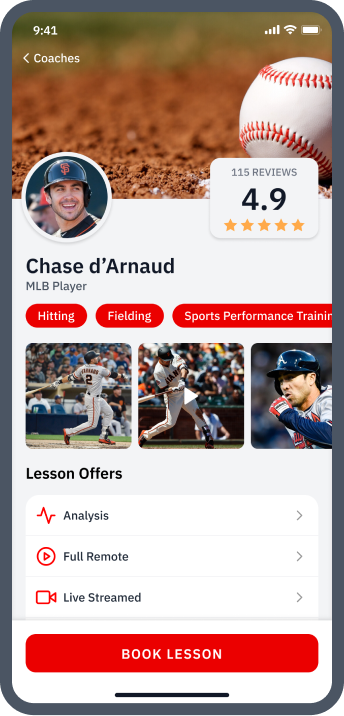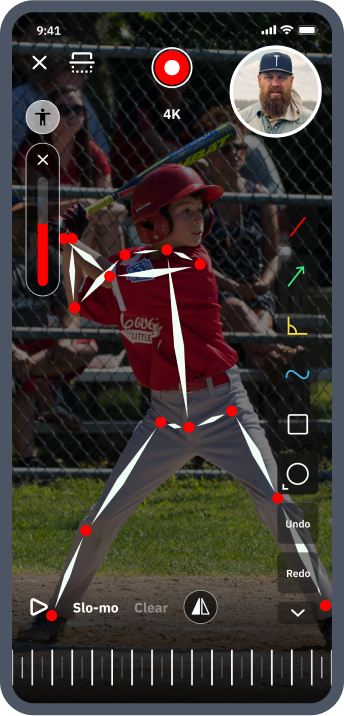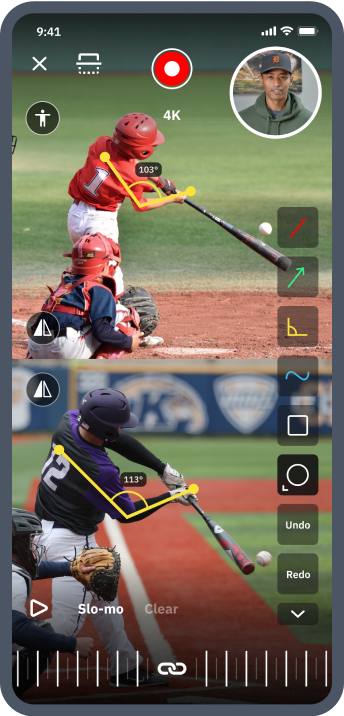Speed and Agility Training for Baseball and Softball

If you’re a baseball or softball player today, then you’ve probably done some speed and agility training.
Modern coaches know that drills focused on increasing an athlete’s speed and agility are linked to better performances in actual sporting events.
But why do they work?
In what parts of baseball and softball specifically do you need power, agility, and speed?
And, most importantly, how do ballplayers develop these attributes?
In this guide to speed and agility training for baseball and softball, we’ll drill down on why these skills are integral to our games, as well as discuss the scientific basis of speed and agility training.
We’ll cover the following topics:
- The three key attributes you need to succeed in baseball and softball
- SAQ training and its components for baseball and softball
- The general science behind speed and agility training
- Infield drills for speed and agility
- Outfield drills for speed and agility
- Baserunning drills for speed and agility
- Considerations for designing a baseball or softball speed and agility program
The Three Key Attributes You Need to Succeed in Baseball and Softball
To play every position and complete almost any game-advancing action in baseball or softball, you need power, agility, and speed.
In fact, some experts suggest that they can predict your future performance based solely on these three areas.
On the surface, this all sounds sort of obvious. Of course, you need to be powerful, agile, and fast to succeed in baseball or softball – you need those attributes for lots of other sports too.
But how do these skills translate specifically to baseball and softball?
Let’s look more closely at each attribute and how it plays out in our pastimes.

Explosive power in baseball and softball
Explosive power is crucial in baseball and softball.
If you don’t react quickly or forcefully enough on the field, you will find more failure than the already large amounts that our games dole out.
On defense, infielders and outfielders need a combination of sharp anticipatory skills, perceptual skills, and decision-making skills – but power is needed to actually express these skills in live game scenarios.
Otherwise, you’re just describing a coach.
Pitchers need the same, plus the power reserves and endurance to consistently drive off the mound into their motions – inning after inning if they’re a starter.
Fielders – including pitchers once they release the ball – must read the ball off the bat quickly and decide how to physically make the appropriate play.
Being able to run, cut angles, or dive requires raw explosive power, while practice, timing, and what’s known as baseball or softball IQ allows the player to explode in the right direction and at the right time.
On offense, players need power to generate effective swings that square up the ball into play, and after contact, they need it to blaze through first base and beyond.
All baserunning requires a degree of explosiveness, whether it’s diving back to the base to foil a back-pick, stealing second, legging-out a double, or hook-hand-sliding safe at home as the tag slaps by a millisecond too late.

Agility in baseball and softball
It’s not enough for baseball and softball players to react quickly and forcefully. They must also do so efficiently.
Efficiency hints at the idea of ease within the acceleration and deceleration of the movements, AKA starting and stopping, which is an important component of all agility.
Agility is also tied to quickness, which can help speed but does not necessarily determine speed.
Speed can still be speed even if it’s linear – like a sprinter coming straight out the gate – whereas agility exists through multiple planes of movement.
A third baseman fielding a dribbler and throwing across their body on the run in time for the putout at first or a baserunner emerging from a rundown between second and third unscathed are textbook examples of agility in baseball and softball.
Additional agility also gives a fielder more range in all directions, allowing them to close the distance between themselves and the ball more quickly and while using less energy.

Speed in baseball and softball
Now, onto our need for speed.
Speed in baseball and softball is about more than baserunning, though it might be your first thought.
As stated above, infielders and outfielders must also move quickly from point A to point B to make a play.
It’s estimated that a single player may have to cover a maximum of 39-43 feet in one play.
It’s common for infielders to cover between 9-20 feet on one play, and for outfielders to stretch between 19-43 feet in a single play.
That’s a lot of ground to cover.
Speed on the base paths is, of course, essential as well.
But this speed has to work in conjunction with explosive power, reactive agility, situational awareness, and decision-making skills if a baserunner wants to advance or put themselves in scoring position regularly.
Most of us have seen and tried holding back our frustration at a natural-born speedster running into out after out because they have yet to hone these other essential attributes that add up what we call baseball or softball IQ.
Okay, it’s easy to see how explosive power, agility, and speed make baseball and softball players successful. But how do we actually train these attributes?

SAQ For Baseball and Softball Training
On his website, exercise physiologist and researcher Sean Cochran discusses these three vital traits as well – only he refers to them as speed, agility, and quickness (SAQ).
If you want to improve these skills, you must engage in specialized training.
But how does this training work, and what are some examples?
How SAQ training works
Training focused on speed, agility, and quickness should “overload the neural, articular, and muscular systems of the kinetic chain,” according to Cochran.
For Cochran, speed, agility, and quickness (SAQ) training means overloading these systems – pushing them further than they’ve gone before.
The more stress you put on the kinetic chain, the more it accommodates, improving speed, agility, and power to keep up.
Because your kinetic chain is consistently adapting to the overload, you have to push yourself a little further with each training session.
Only by progressing will you maintain the SAQ needed to perform well in baseball or softball.
The best training to improve SAQ in baseball and softball will involve foot speed, changing direction, first step explosive power, and acceleration.
Let’s look at each of these in more detail.

Foot speed
Baseball and softball players need to be the fastest when running the bases and playing the outfield.
To improve foot speed, you need to get better at sprinting.
Specifically, this entails increasing both stride length and stride frequency.
You can improve stride length and frequency with plyometrics, jump training, and Olympic lifting.
But also, by perfecting your sprinting technique and ironing out any inefficiencies in your overall running mechanics.
As if being faster and more energy-efficient weren’t enough, there is a third reason that baseball and softball players should take their running mechanics or lack thereof to heart.
Freak athletes with once-in-a-blue-moon-raw-talent aside, many coaches and organizations want athletes that already possess the basics because it saves them time and training resources in the long run.
Poor running mechanics might lead some recruiters and scouts to assume that you either do not receive professional performance training at all or that you don’t take it seriously.
Luckily, running mechanics is something that most ballplayers have a ton of control over, and it does not require natural talent – just reps and sweat.

Changing direction
Quickly changing direction requires a player to decelerate in one direction and accelerate in another rapidly.
The hotbox scenario of a player caught between second and third from earlier is a quintessential example.
To be good at changing direction quickly, ballplayers must improve their force outputs and balance.
Force outputs are increased by the same prescription that permeates the other aspects of SAQ – overload.
Balance refers to your ability to stay in control of your body's position. This is how most of us think about the concept of balance.
However, in reference to changing direction, here we are also referring to another, sometimes overlooked, component of speed and agility – imbalances.
These imbalances are the ones found when comparing one side of your body to the other.
And they are exceedingly common in our sports, because most ballplayers only swing and throw on one side of their body over and over for their entire playing careers.

First step
To improve acceleration, you have to work on what’s called your first step speed.
The first step out of the batter’s box or the first step as you steal a base must be quick and explosive.
To improve your first step velocity, you have to work on your acceleration – which often comes down to increasing power generation.
Acceleration
Acceleration is your ability to speed up, not how fast you run.
To make yourself speed up, you have to work on the same exercises as you do for foot speed and most of these other aspects of SAQ:
- Plyometrics
- Jump training
- Olympic lifting.
Other training techniques like uphill sprinting, running with weighted vests, downhill running, sled pushes and towing can also improve a ballplayer’s acceleration.

The Science Behind Speed and Agility Training: Why Does It Work?
Now that we’ve gotten a taste of what speed and agility training involves in baseball and softball let’s pause and reflect a moment.
We know, even intuitively, that speed and agility training, or SAQ training, is essential at the uppermost levels of baseball and softball.
But why is it essential? What does this type of training do to your body that makes it so beneficial?
Dr. Bruce W. Craig broke down the science of speed and agility for the National Strength and Conditioning Association’s journal in 2004.
He starts with the neural adaptation that the body undergoes during speed and agility training – this adaptation is necessary for improvement.
Adaptation is a function of muscle fiber recruitment patterns, which themselves depend on both the central nervous system (CNS) output and our proprioceptive feedback.
Okay, let’s break all this way down.
Receptor organs, like the eyes, ears, and skin, collect external information, which is then relayed via the CNS.
The CNS then interprets this relayed information and sends it back out to so-called “effector” organs – which are mostly the muscles in our case.
The muscle fibers recruited by the CNS carry out the body’s response to the perceived external stimuli – like swinging a bat thunderously at a pitcher hanging a juicy curve.
So that’s how your CNS helps by translating external stimuli, but in order to do this well, it also must coordinate with your internal compass.
This internal compass enables you to navigate the space you occupy as a body, and it’s officially known as proprioception.
It is aided by your body’s proprioceptors:
- Muscle spindles
- Golgi tendon organs
- Various pressure, touch, and motion sensors within your joints
What? You might be asking. Try not to get too bogged down in the terminology.
Essentially, neurons within those funny-sounding words (muscle spindles and Golgi tendons) send their very own signals to our CNS.
These muscle spindles and Golgi tendons send their internal signals when the muscles that the CNS had relayed its external info to begin expanding or contracting.
And it's these signals that prevent your body from over-exerting and injuring itself.
The other proprioceptive sensors mentioned above give you a sense of movement – what it actually feels like to swing a bat, for example – which helps you determine if you’re reacting quickly enough.
Without getting even more complicated, here’s the long and short of it:

Speed and Agility Drills for Baseball and Softball Training Specifically
Now that you know the scientific basis for speed and agility training, let’s look at some sport-specific drills.
Each of these drills tests acceleration, deceleration, visual stimulus identification, and first step speed. They also mimic game situations.
These drills are taken from the work of Mitchel Magrini, J. Jay Dawes, Frank J. Spaniol, and Adam Roberts.
Wanna grow your baseball or softball coaching brand?
Get connected to new local and online lesson clients—along with all the tools you need to scale.
Download the free app

Infield Drills for Speed and Agility
Ball Drops
For this drill, the player starts in an athletic position and the coach stands about 30 feet away. The coach drops a ball randomly from shoulder height.
As soon as it’s dropped, the player sprints forward, picks up the ball with their bare hand, and fakes a throw to first base.
This drill mimics a bunt situation.
Shuffle Ball React
The player stands between two cones about 15 feet apart, with the coach about 30 feet in front of them.
The coach rolls the ball toward one side or another and the player goes to field it either gloved or bare-handed.
As the player tosses the ball back to the coach, the coach quickly rolls the second ball, forcing the player to sprint toward the second ball.
This drill mimics a ball hit to one side of a fielder.
Outfield Drills for Speed and Agility
Y Drill
To start this drill, set up four cones in a Y pattern, each about 27 feet apart.
The player starts at the bottom base of the Y, then sprints toward the second cone at the ventral tip of the “v”.
Once the player reaches the second cone, the coach tosses a ball toward one of the two remaining cones on the left or right, cone A or cone B.
The player then sprints toward the ball and attempts to catch it.
This drill mimics when an outfielder has to catch a fly ball that is over their head.
Forward Changes
The player starts in an athletic position with the coach standing about 15 feet away.
The coach tosses or rolls the ball in the player’s general direction, and the player immediately sprints toward the ball to pick it up or catch it and fake a throw to the infield cutoff.
This drill mimics a play when an outfielder has to hit a cutoff person.
Baserunning Drills for Speed and Agility
Acceleration Runs
The player starts in a baserunning stance with the front foot on a starting line. At a visual cue – like a pitcher entering their delivery – the player reacts, rotates, and accelerates 27-81 feet.
This drill mimics stealing a base on first move.
Get Up and Go’s
The player starts by lying on their stomach in a push-up position.
On a visual signal, the player jumps to their feet and sprints forward about 27 feet.
At the 27-foot mark, the coach gives the player a signal to either stop where they are or keep going to the 81-foot line.
This drill mimics a passed ball situation or a baserunner having to get up from sliding position to advance to the next base.

Speed and Agility Drills for More Advanced Ballplayers
All of these drills above are sports-specific and easily added to field practice with little to no equipment necessary. These drills can be used for both beginners and advanced ballplayers.
However, for older and more advanced ballplayers, you will also want to incorporate something like the SAQ recommendations into your training to maximize your speed and agility gains.
As a reminder, these included:
- Plyometrics
- Jump training
- Olympic lifting
There are also some supplemental things ballplayers can do to improve their speed and agility, like:
- Uphill sprinting
- Running with weighted vests
- Downhill running
- Sled pushes
- Towing drills
These training types require a qualified in-person or remote instructor to make proper physical assessments, teach and check technique, and create safe and effective programming.
No matter where you are in your ballplayer’s journey, having and sticking to an effective overall program is what’s most important.

Considerations for Designing a Baseball or Softball Speed and Agility Training Program
Magrini et al. give best practice suggestions for coaches who want to design speed and agility programs:
- Prefer quality reps and drills over quantity
- Do agility sessions at minimum twice per week
- Cover approximately 984-1968 feet per session
- Don’t ask your athletes to perform speed work under significant fatigue (at that point, you’re no longer training speed and agility, but endurance)
- Allow enough rest between repetitions
- Good work-to-rest ratios for baseball and softball speed and agility drills is between 1:5 and 1:20

Wrapping Up
Speed, agility, and explosive power are integral to baseball and softball.
Players who want to improve, no matter which level or position they play, can benefit from training for speed and agility.
Now go out and use these drills and insights to help achieve your goals.
Unlock your ballplayer’s full potential
Find the perfect vetted coach to build a solid foundation or take your player's skills to new heights.
Download the free app

About the Authors
Courtney Withrow
Professional Writer
Originally from the U.S., Courtney is a Brussels-based freelance writer with a Master’s degree in International Relations. She grew up playing softball and still loves the game.
Dr. Edgar Rodriguez DC, CCSP.
Founder of EROD Sports Medicine & Training
Doctor Edgar Rodriguez DC, CCSP, is recognized as a leader in both sports chiropractic and performance fields. He's currently an adjunct professor at the University of La Verne.

